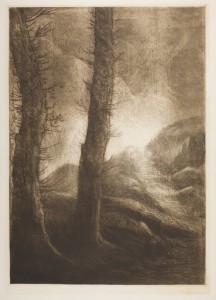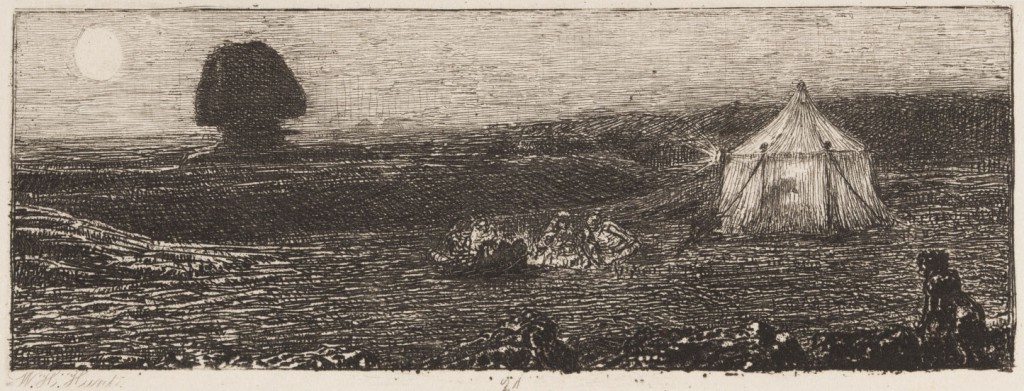This post is one in a series highlighting the special exhibition Nightfall: Prints of the Dark Hours, which explores evocative artistic images of night, called nocturnes. The exhibition is on view through March 22, 2016, in the VMFA Works on Paper Focus Gallery. Admission is free.
Nighttime, a period in which darkness and drowsiness often coexist, has a way of distorting one’s visual, spatial, and even emotional perceptions. This toying with perceptions provides a great deal for artists to play with in depictions of the night. Two artists featured in Nightfall—Alphonse Legros (French, 1837–1911) and William Holman Hunt (English, 1827–1910)—use scale to explore the different effects night has on how one views objects.

Alphonse Legros (French, 1837–1911), Large Trees, Effects of Evening Light (Effet du Soir), late 19th century, etching, aquatint, drypoint, 26 1/2 x 19 in. Promised Gift of Frank Raysor, FR. 2966
The title of Alphonse Legros’s etching, Large Trees: Effects of Evening Light (Effet du Soir), sums up the subject quite literally: at approximately 22 x 16 inches, the extraordinarily large image depicts a woodland landscape seen against the setting sun. By choosing so big a format for this composition, Legros demonstrates not only his technical prowess as a printmaker but also his artistic understanding of the processes of seeing and understanding. Trees are oftentimes presented as relatively small within the world of an image, putting everything to scale and retaining a sense of the world as being represented in full. By contrast, Legros presents only the lower portions of the titular trees—which are presumably much larger—so this print becomes more a view of this scene as one would see it in real life, as opposed to the typical distant, omniscient point of view of a landscape. This vantage point highlights the sun’s lending over of self to the darkness of night, making the scene all the more lustrous as the trees become silhouettes against the illuminated backdrop.
William Holman Hunt’s The Desolation of Egypt (1857) likewise disrupts the viewer’s preconceptions of what ought to be emphasized in an image of a recognizable, if not iconic, object. Contrary to what is expected, he places the famed Great Sphinx of Giza shrouded in shadows at the far left of the background of a tiny image. Hunt, a cofounder of the experimental British artistic group called the Pre-Raphaelite Brotherhood, created this piece during a series of trips to biblical sites in Palestine and Egypt. This print, originally tilted Sphinx, shows Hunt (alone in his tent) and his crew at their campsite during his trip to Giza. As Hunt recalled:
One morning, after an unexpected experience of the unparalleled hardness of a bed in the sand, with a resentment which extended to the wind, also contributing to spoil my night’s rest, I felt but little inclined to acknowledge that dawn was sufficiently declared for me to regard rest as altogether at an end.

William Holman Hunt (English, 1827–1919), The Desolation of Egypt, 1857, etching and drypoint on chine collé, 8 1/2 x 12 3/16 in. Promised Gift of Frank Raysor, FR.6099
This sort of mundane complaint made in a place so regarded with wonder as the Giza Plateau evokes the disconnected mode in which Hunt represented his stay near the monumental Sphinx. Although easily recognizable in form, it is uncustomary to see the Great Sphinx portrayed in such a fashion: as just something else in the dark background of a scene that highlights much less mystified human activity.
The subject of nighttime allows artists greater opportunities to enhance the role of perception in their work, both visually and psychologically. By exploring scale in particular, Legros and Hunt created very personalized representations of subjects that do not generally lend themselves to unique images.
Bailey Goldsborough
Curatorial Intern,
VMFA Department of European Art